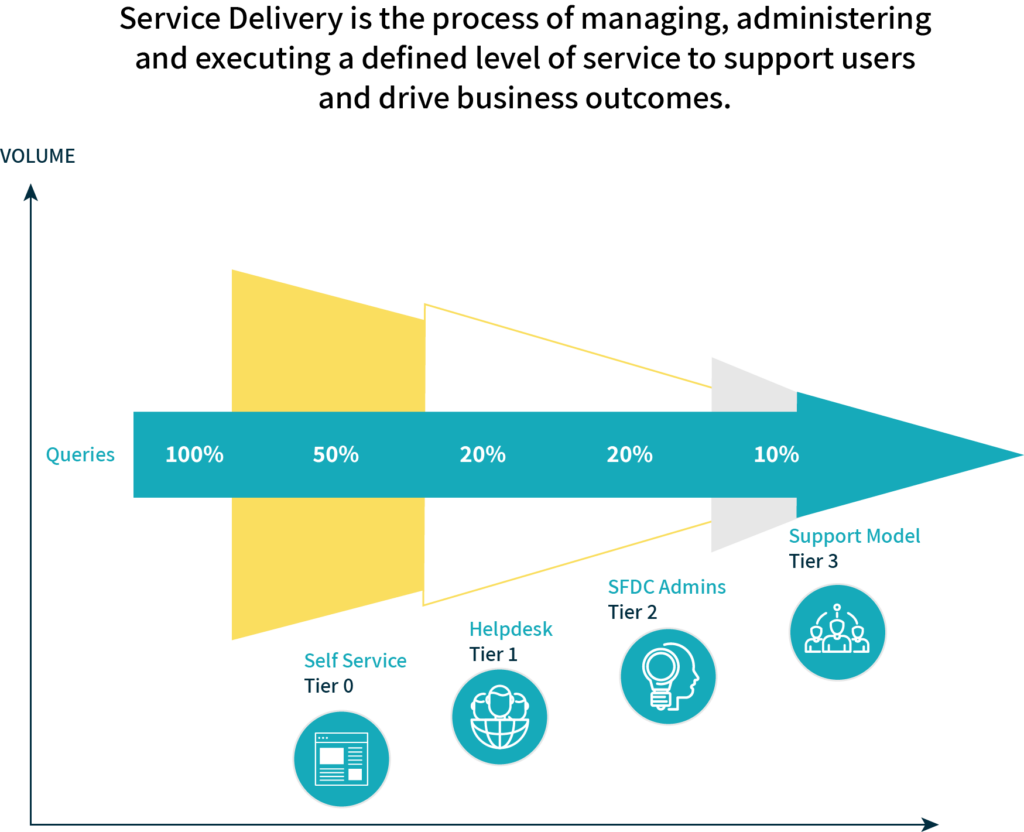The last five posts in our six-part Center of Excellence (COE) series have covered:
The team roles and structures of a COE
The delivery standards and processes a COE should put in place
How to establish an effective governance model
Why a tiered support system is vital to Salesforce success.
In this last post of the series, we make the case for why ongoing learning is the best way to get the most out of a rapidly evolving platform like Salesforce.
Salesforce is constantly evolving and expanding its capabilities.
The breadth of the overall Salesforce platform(s) has grown tremendously over the past 20 years. At one time, it was reasonable for one to be familiar with all of the features Salesforce had to offer. Now, no matter how seasoned you are, it’s nearly impossible to know all there is to know about Salesforce. Part of this is because of the continuous innovation Salesforce pushes with its three annual releases. Salesforce’s penchant for acquisitions is also contributing to this, with CPQ, Mulesoft, Marketing Cloud, and Tableau now large enough to support entire sub-ecosystems of partners, consultants, and apps.
In the past, traditional platforms would release updates maybe once a year. Many organizations wouldn’t even install the new releases because it was such a manual process and had the potential to break customizations already in place. Some organizations might choose to wait for three releases down the road and take a year to make the necessary updates. Even then, things still might break.
Salesforce has shifted that paradigm, releasing hundreds of new features three times a year as part of their subscription model — not something extra for which customers have to pay. While these releases might impact existing features and make certain features obsolete, for the most part, they don’t break customizations the way updates might in the old model. And often times these new features will replace a previous customization that makes your instance better in the long run.
While this is all great, it makes it even more imperative to educate yourselves, your employees, and your users on how these new features best fit into your business and how to properly take advantage of them. With releases happening so frequently, it’s not always easy to stay up-to-date on what every new release is offering, but if you set create habits around continuous learning, it can help.
Where is the best place to start learning Salesforce?
The first place anyone should look is Trailhead, Salesforce’s free online learning platform that releases bite-sized learning content that can be consumed in anywhere from five minutes to five hours. Trailhead content covers everything from deep dives on new features to release readiness. And given that it’s self-serve, Trailhead meets users where they are, allowing users to learn at their own pace from anywhere they are. The new Trailhead GO mobile app is a great example of this. It gamifies the experience with assessments, badges, and points that need to be earned to help track progress, which gives users a tangible form of accomplishment and allows managers to know that information is actually being absorbed versus going in one ear and out the other.
If you want to take it a step further, you can incorporate myTrailhead into your ongoing education. For $25 a user a month, myTrailhead allows a company to customize Trailhead with their own brand and assign teams learning content. You can also create your own content that is tailored specifically to how your company has designed and implemented Salesforce.
There are other ways to create a culture of learning in your organization beyond using Trailhead. Simply scheduling review meetings after each release to assess and debate the impact of new features or discuss lessons learned can go a long way. Assign each team member a section of these meetings to own and present so it doesn’t fall to one person on the team.
And last but certainly not least, it helps to stay on top of how others are using and working with Salesforce. Conferences — even virtual ones, which might be our new reality for the foreseeable future — are great for this. My favorite conference put on by Salesforce is actually TrailheaDX, which I find easier to navigate than the company’s giant Dreamforce conference. If you’re lucky enough to have a local user group, try out a meeting. Or, if it’s available, join their Slack group. Salesforce offers a list of local Trailblazer Community Groups on https://trailblazercommunitygroups.com/. If you don’t see a user group in your area, start one of your own!
Continuous learning is a big focus for us here at 10K, and it’s what I believe sets apart the best consultants and COEs from all the others out there. If you are a COE leader reading this, I can’t stress enough the importance of setting aside time in both team and individual schedules for learning.
Having a COE in place with the right team, structures, and processes around your Salesforce program can make a huge difference when it comes to seeing a higher return on your Salesforce investment and making Salesforce an integral part of your business.
Download our guide to maximizing your Salesforce program ROI with a Salesforce COE.


